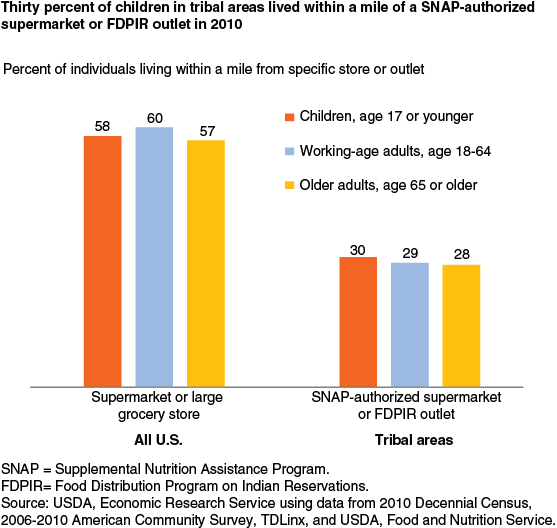Measuring the Food Access Gap in Native American Tribal Areas
- by Michelle Saksena
- 12/7/2015
USDA’s Supplemental Nutrition Assistance Program (SNAP) provides eligible low-income households with monthly benefits to purchase food in authorized stores. This assistance is only effective if SNAP-authorized grocery stores are easily accessible. But, in many American Indian and Alaska Native tribal areas, low population densities and high poverty rates deter large stores—with the requisite food variety to be authorized to accept SNAP benefits—from locating in these areas.
To lessen this lack of food access, USDA funds an alternative program—the Food Distribution Program on Indian Reservations (FDPIR). USDA purchases and ships selected healthful foods to Indian Tribal Organizations or State governments. Tribal areas served by FDPIR use warehouses, tribal stores, and local sites to distribute the USDA foods. In fiscal 2014, an average of 85,400 people participated in FDPIR each month.
Households living on tribal lands who qualify for food and nutrition assistance can switch between SNAP and FDPIR on a month-to-month basis if they choose to do so. Thus, to determine food access for low-income people living in tribal areas, distances to both SNAP-authorized supermarkets and FDPIR outlets must be considered. A 2014 ERS study using Geographic Information System (GIS) methods calculated distances to SNAP-authorized supermarkets and FDPIR outlets in 2010 for individuals in three types of tribal areas: American Indian Tribal Areas, Oklahoma Tribal Statistical Areas, and Alaska Native Village Statistical Areas. The average percent shares for three age groups of individuals (children 17 and younger, working-age adults 18-64, and older adults 65 and older) living in Native American tribal areas were estimated using weighted averages.
Nationally, 58 percent of children and 57 to 60 percent of adults lived within walking distance (1 mile or less) to a supermarket or large grocery store in 2010. In Native American tribal areas, the percent of individuals living within walking distance of a SNAP-authorized supermarket or FDPIR outlet is half the national average. (Supermarkets were defined as food stores with annual sales of $2 million or more.) ERS researchers found that 30 percent of children, 29 percent of working-age adults, and 28 percent of older adults in Native American tribal areas lived 1 mile or less from a SNAP-authorized supermarket or an FDPIR outlet in 2010.
This article is drawn from:
- Dicken, C. & Williams, R. (2014). Measuring Access to Healthful, Affordable Food in American Indian and Alaska Native Tribal Areas. U.S. Department of Agriculture, Economic Research Service. EIB-131.
- Ver Ploeg, M., Breneman, V., Williams, R., Snyder, S. & Dicken, C. (2012). Access to Affordable and Nutritious Food: Updated Estimates of Distance to Supermarkets Using 2010 Data. U.S. Department of Agriculture, Economic Research Service. ERR-143.


